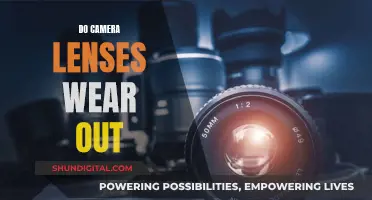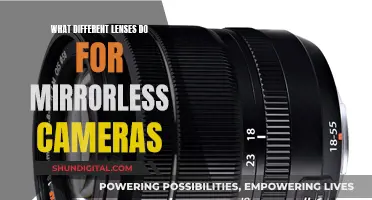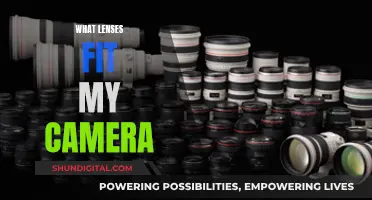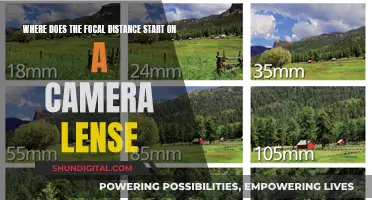
Camera lenses come in a variety of sizes and types, each serving a different purpose and catering to the photographer's needs. The two main categories of lenses are prime and zoom lenses, which differ in their functionality and versatility. Prime lenses have a fixed focal length, making them lighter and more affordable, while zoom lenses offer variable focal lengths, allowing for more control over the shot without changing one's position.
Within these categories, there are standard, wide-angle, and telephoto lenses. Standard lenses, with focal lengths between 35mm and 85mm, offer a field of view similar to the human eye, making them a popular choice for street, travel, and portrait photographers. Wide-angle lenses, with focal lengths between 14mm and 35mm, provide a broader scope, making them essential for landscape and architecture photography. Telephoto lenses, on the other hand, offer incredible magnification for capturing distant subjects and are commonly used in sports and wildlife photography.
Additionally, there are super-telephoto, tilt-shift, and macro lenses for more specialised applications. Super-telephoto lenses provide even greater magnification than standard telephoto lenses, making them ideal for astrophotography. Tilt-shift lenses allow for the distortion and manipulation of perspective, often used in architectural photography to ensure buildings appear upright. Macro lenses, on the other hand, enable photographers to capture extreme close-ups of tiny subjects, such as insects or flowers.
| Characteristics | Values |
|---|---|
| Purpose | Portraits, street photography, wildlife photography, sports photography, landscape photography, architecture photography, night photography, low-light photography, etc. |
| Focal Length | The focal length of a lens determines its angle of view and how much the subject will be magnified. |
| Zoom | Zoom lenses have variable focal lengths, while prime lenses have a fixed focal length. |
| Aperture | The aperture of a lens refers to the amount of light it can gather and its ability to blur the image background. |
| Image Stabilization | Some lenses include optical stabilization units to counteract the blurring effects of hand shake. |
| Format | The format of a lens describes the sensor size it is designed to work with. |
| Lens Mount | The lens mount determines whether the lens will physically fit the camera. |
| Angle of View | The angle of view offered by a lens is described as the view captured between the furthest extremes of the lens's coverage. |
| Depth of Field | This describes how much of the scene in front of and behind the point of focus appears sharp and in focus. |
| Speed | An informal way of describing a lens' aperture in terms of its relation to exposure time. |

Zoom lenses vs. prime lenses
There are two main types of camera lenses: zoom lenses and prime lenses. The main difference between the two is that zoom lenses have a variable focal length, while prime lenses have a fixed focal length. This means that with a zoom lens, you can change the magnification of your subject by turning the zoom ring, whereas with a prime lens, the only way to change the magnification is by physically moving closer to or further from the subject.
Zoom Lenses
Zoom lenses are incredibly versatile and are a good choice if you need to adapt quickly to moving subjects or are unsure of the conditions you'll be shooting in. They are also a good option if you have limited space to move around and need to be able to change the field of view without changing your physical position. Zoom lenses tend to be heavier than prime lenses, and they may not be as sharp. Additionally, zoom lenses typically have smaller maximum apertures, which can make it more difficult to shoot in low-light conditions or achieve a shallow depth of field.
Prime Lenses
Prime lenses offer several advantages over zoom lenses. They are generally less expensive, lighter, and sharper. They also typically have larger maximum apertures, which makes them better suited for low-light photography and creating a shallow depth of field. Prime lenses can also force you to be more creative with your compositions, as you have to physically move to change the framing of your shot. However, the fixed focal length of prime lenses can be limiting in certain situations, such as wildlife photography, where you may not be able to get close enough to your subject.
The answer to this question depends on your specific needs and preferences as a photographer. Most photographers end up using a combination of both zoom and prime lenses, depending on the situation. If you need versatility and the ability to quickly adapt to different situations, a zoom lens is a good choice. On the other hand, if you want a lightweight lens that offers superior image quality and low-light performance, a prime lens might be a better option. Ultimately, the best way to decide which type of lens is right for you is to try them out and see which one suits your shooting style better.
Repairing Galaxy A20 Camera Lenses: A Step-by-Step Guide
You may want to see also

Wide-angle lenses
A lens is typically considered "wide-angle" when its focal length is less than 35mm. This translates to an angle of view that is greater than 55° across your photo's widest dimension. Ultra-wide lenses usually have focal lengths of 20-24mm or less.
To use a wide-angle lens effectively, you need to have something close to the lens. The key is to experiment with different techniques and compositions. Get closer to the foreground and immerse yourself among your subjects. Carefully place near and far objects to achieve clear compositions. Point your camera at the horizon to avoid converging verticals. Be aware of how distortion may impact your subject.
The Ultimate Mirrorless Camera for Limitless Lens Options
You may want to see also

Telephoto lenses
The focal length of a telephoto lens determines its angle of view and how much the subject will be magnified. Longer focal lengths require shorter exposure times to minimise blurring caused by shaky hands. Telephoto lenses are more susceptible to camera shake as small hand movements become magnified.
The simplest telephoto lens can be regarded as having two elements: one converging and the other diverging. In practice, more than one element is used in each group to correct for aberrations. The combination of these two groups produces a lens assembly that is physically shorter than a long-focus lens, but produces the same image size.
The front (object-facing) elements in a telephoto lens collectively have a positive focus, with an overall focal length that is shorter than the effective focal length of the lens. The converging rays from this group are intercepted by the rear (image-facing) lens group, which has a negative focus. This second group of elements spreads the cone of light so that it appears to have come from a lens of much greater focal length.
How Camera Lenses Use Refraction to Capture Images
You may want to see also

Focal length
The focal length of a lens determines its angle of view and how much of a scene will be captured, as well as the magnification of individual elements within the frame. Longer focal lengths result in narrower angles of view and higher magnification, while shorter focal lengths provide wider angles of view and lower magnification. This is why longer focal lengths are often described as being more "zoomed in".
There are two main types of lenses: prime lenses and zoom lenses. Prime lenses have a fixed focal length, meaning you cannot zoom in or out. Zoom lenses, on the other hand, offer variable focal lengths, allowing you to capture a wider range of scenes without having to change lenses. Zoom lenses are generally bulkier and heavier than prime lenses, and they tend to be more expensive.
The focal length of a lens also affects the perspective of an image. While changing the focal length on its own does not alter the perspective, it often requires the photographer to change their physical position relative to the subject, which does change the perspective. Wide-angle lenses with shorter focal lengths can exaggerate or stretch the perspective, making objects appear more distant from each other, while telephoto lenses with longer focal lengths compress or flatten the perspective, making objects seem closer together.
Different types of photography call for different focal lengths. Landscape photographers often use wide-angle lenses to capture vast vistas, while portrait photographers tend to favour longer focal lengths to achieve a flattering perspective and a shallow depth of field that blurs the background. Sports and wildlife photographers often use telephoto lenses with very long focal lengths to get close-up shots of distant subjects.
In summary, focal length plays a crucial role in photography, influencing the angle of view, magnification, and perspective of an image. By understanding focal length, photographers can choose the right lens and compose their shots effectively to capture the desired scene.
Why Are Camera Lenses So Affordable?
You may want to see also

Aperture
The f-number is calculated by dividing the focal length of the lens by the diameter of the aperture. A lower f-number denotes a greater aperture, which allows more light to reach the film or image sensor. For example, f/2 allows for exposure times one quarter that of f/4.
Different lenses have different ranges of aperture settings, with maximum and minimum aperture sizes. Lenses with large maximum apertures are known as "fast" lenses as they can pass through more light and are useful in low-light situations.
Camera Lenses: Scratch-Resistant or Not?
You may want to see also
Frequently asked questions
The size of a camera lens impacts its functionality and the types of images it can capture. Different lenses have different focal lengths, which determine the angle of view and how much of the subject will be magnified. Wide-angle lenses have shorter focal lengths, while telephoto lenses have longer ones.
A prime lens has a fixed focal length and tends to be lighter and cheaper than other lenses. They often have a wider maximum aperture, but they are less versatile and require more frequent lens changes.
A zoom lens has a variable focal length within a particular range, allowing you to control the shot more without changing your physical position. They tend to be more expensive, heavier, and have smaller maximum apertures than prime lenses.
A standard lens has a focal length between 35mm and 85mm, providing a field of view similar to the human eye. They are popular among street, travel, and photojournalism photographers, as well as for portrait photography.
A wide-angle lens has a focal length between 14mm and 35mm, offering a panoramic view with a broad scope from side to side. They are commonly used for landscape, architecture, and real estate photography.







